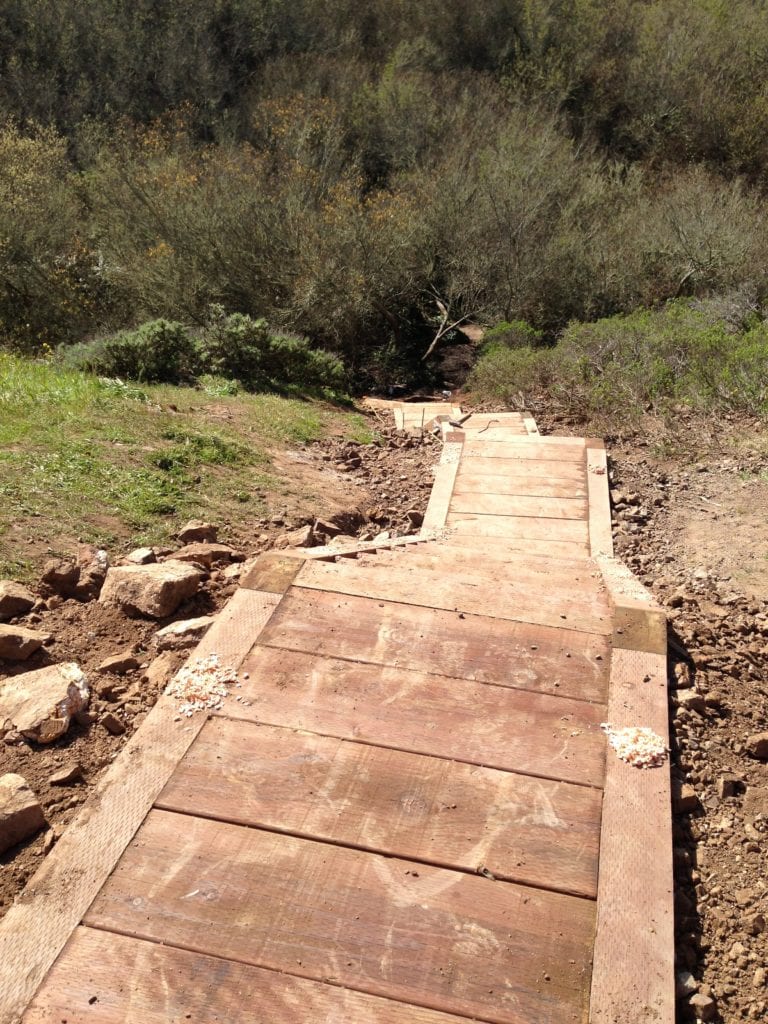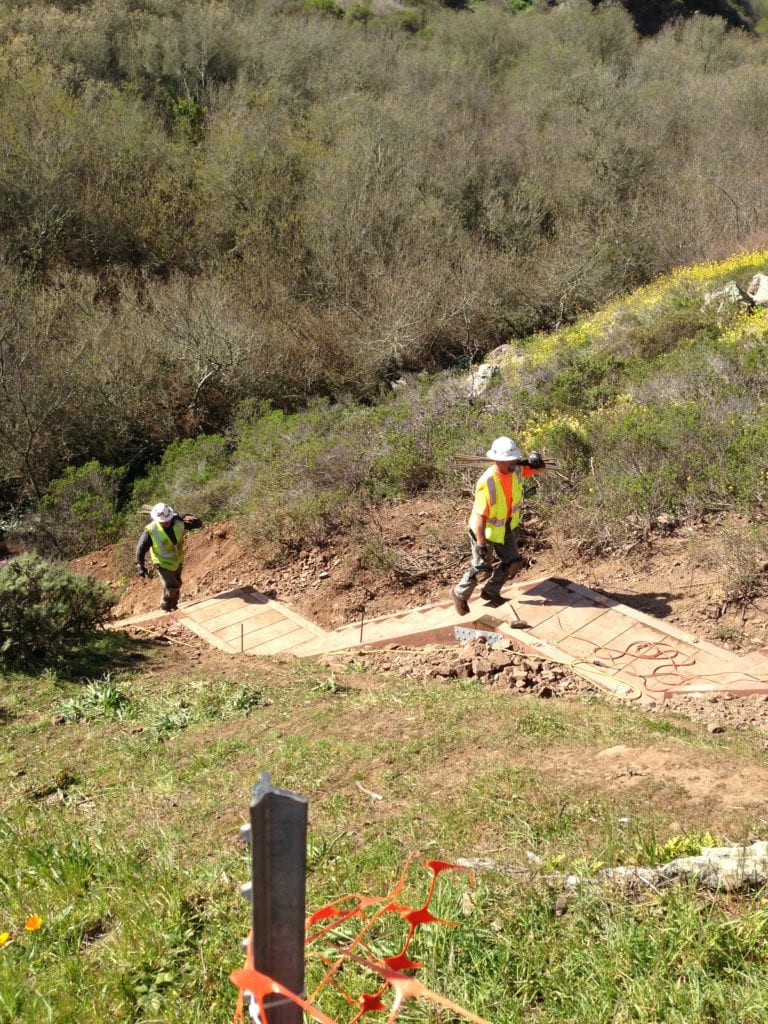
Story and photos by Murray Schneider
The Recreation and Park’s Natural Areas Program’s Saddle Trail Project that began on January 16 with the construction of 62 box steps along the canyon’s eastern slope was completed on March 1, after construction workers from Yerba Buena Construction Company spent the month of February building a series of narrower stringer steps that stretch along a western slope of Glen Canyon.
Christopher Campbell, a Rec and Parks Natural Area Program manager, inspected the stringer step construction work on February 20 more than halfway through that portion of the project. “Altogether, 26 steps have now been placed,” he said then. “Rain and the hardness of the chert slowed the work.”
A week later, on February 27, workers from Yerba Buena continued hauling materials up the work-in-progress.
Two days afterward, on March 1, the entire project was completed, ready for Glen Canyon Park day-trippers to enjoy. “This is an incredibly rocky hillside,” said Mike Hawley, a 30-year veteran working construction.
Hawley pointed to a worker below him slinging a sledgehammer and another wrestling a bucking jackhammer. Hawley hails from Yosemite where he has decades of experience building mountain steps. “This is a steep slope and these guys did great work.”
 The earlier Saddle Trail Project component had positioned 62 box steps on the eastern canyon slope, which now allow hikers to ascend from the Willow Loop Trail to a series of switchbacks that punctuate two chert outcroppings 120 feet from the canyon floor.
The earlier Saddle Trail Project component had positioned 62 box steps on the eastern canyon slope, which now allow hikers to ascend from the Willow Loop Trail to a series of switchbacks that punctuate two chert outcroppings 120 feet from the canyon floor.
The 62 box steps, some weighing as much as 135 pounds, end at a 120-foot canyon crest, which then morph into switchbacks that thread through two chert rock outcroppings. The stringer steps are the last leg of the journey, descending from the switchbacks.
Steve Walker, Hawley’s Yerba Buena co-worker, joined Hawley at the top of the narrow stringer steps on February 27. “This is second nature to us,” Walker said. “There will be 70 stringer steps when all is said and done.”
Funded by a $157,000, 2008 California Department of Parks and Recreation Habitat Conservation Fund Grant, the Rec and Parks’ Natural Areas Program project is designed to prevent erosion and increase recreational access to Glen Park’s 70-acre canyon.
Lisa Wayne, manager of the Natural Areas Program, wrote the grant that is consistent with the NAP land management mission, which seeks to protect Glen Canyon’s arboreal, plant, grass and riparian habitats.
The Saddle Trail Project is the third leg of the Wayne-written grant, which late last year funded sediment removal along Islais Creek and removal of invasive Cape ivy along a trail that leads to Diamond Height’s Turquoise Way.
Well over 400 habitat friendly California native plants complement the 62 box steps, put in place on January 19. Volunteers from Friends of Glen Canyon Park planted 50 of these plants. The coyote mint, silk tassel, coyote brush and California sage that embroider the hillside go hand-in-hand with the adjacent native grasses, which provide sanctuary and sustenance for canyon animals, birds and insects.
“We wanted to mirror canyon plants and plant composition,” said Christopher Campbell, a week after volunteers Ken and Monika Lewis and Kathy Velykis planted the shrubbery.
The rock bed housing the stringer steps is chert, the same geological formation that makes up the two outcroppings bookending the saddle. Canyon amblers had access to the completed box step portion of project since January 23. On February 6, the western slope was cordoned off by fencing and caution tape so Yerba Buena laborers could commence with stringer steps work.
The Saddle Trail Project should not be confused with the 2008 Glen Park Renovation Project, which is scheduled for completion in November 2013 and funded by the 2008 Clean and Safe Neighborhood Parks Bond. The same day that Mike Hawley and Steve Walker shouldered rebar up the stringer steps, workers paralleling Elk Street at the front of the canyon hauled debris from where tennis courts stood only weeks before.
Standing half way up the western slope a week before March 1, surrounded by hammers, shovels, electrical cord, buckets and jackhammers, Christopher Campbell surveyed what had already been accomplished. He watched several day hikers crest the hill, negotiating the switchbacks that themselves will eventually be feathered with California native plants and shrubs, enriching further the park experience for everyone.
“It’s about access as well as erosion control,” Campbell said. “These steps improve access.”
Two days before the project’s completion, Mike Hawley pronounced them good. “These steps will outlast us all.”
